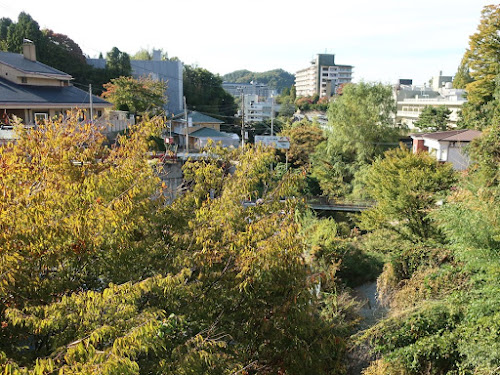Japan has about three thousand onsen hot spring resorts. Arima is
called one of the Three Great Hot Springs along with Kusatu and Gero. The
emperor visited Arima in the 7th century, so it is a long-standing resort. Han-Shin Awaji Earthquake in 1995 broke down a building of Gokurakuji
temple and the relic of the bathtub appeared. It is a possible bathtub
of Toyotomi Hideyoshi who was a ruler in the 16th century and also an Arima devotee. He was promoted as “Taiko” which was the highest position of the dynasty, so this museum was named "Taiko-no-yu(bathtub)". It shows us the relic and excavated artifacts. Most of Japanese love a hot spring, it's fun for us!
 |
Gokurakuji temple which was established in
594
594年、聖徳太子によって創建されたという極楽寺
|
 |
The museum is in the side of the main hall
and it is on the relic.
本堂の脇から史料館に入っていく。遺構の上に史料館がある。
|
温泉大国日本で、草津、下呂とともに日本三名湯と言われる有馬温泉。7世紀には舒明天皇が行幸していた。1995年の阪神淡路大震災で極楽寺の庫裏が壊れ、その下から言い伝えがあった「太閤山の湯殿」とみられる遺構が発見された。有馬温泉好きの豊臣秀吉の湯槽だ。その出土品や遺構が展示されている。日本人にとって温泉と温泉場は鉄板の楽しみだ。
History of Arima onsen、有馬温泉の歴史
The bathhouses are drawn in the center. Arima had only one bathtub (about
7.9m width and 6.4m long) which was separated by the wall in the center. And
two bathhouses, Ichi(The first)-no-yu(bathhouse) and Ni(The second)-no-yu(bathhouse),
were on it. Each bathhouse allotted ten inns. Ichi-no-yu, Ni-no-yo and Yu-na,
who controlled the bathhouse, were abolished in 1883.
By the way, many visitors who looked happy were depicted around the
bathhouses. After 1868 when the foreign settlement was built in Kobe (opposite side
of the Rokkou mountains), many foreigners visited Arima and enjoyed the hot
spring for their summer vacation.
稲野笹有馬小鑑:中央に一の湯と二の湯が書かれている。有馬温泉には、7.9m×6.4mほどの湯船を2つに仕切った「一之湯」と「二之湯」のしかなくそれぞれに10の宿が割り振られていたという。一の湯と二の湯も、ここを仕切っていた湯女も1883年に廃止とある。湯の周りの家には温泉リゾートを楽しんでいる人たちがいっぱい描かれている。
1868年の神戸開港後は、夏場を過ごしやすい有馬に多くの外国人が訪れ温泉を楽しむようになったという。
 |
The list of famous people, who visited
Arima since the 7th century, includes Princess of Monaco (Grace P.
Kelly)
|
The possible bathtub of Taiko、太閤の湯殿の遺構
 |
| Excavated bathtub、発掘された浴槽 |
Kin(Gold)-sen(hot spring) in Arima contains higher concentration of salt than sea water, and it contains iron, too. The color is brown. It seemed to be an open-air bathtub on the heights where we can see the view of Arima. I imagined the cheerful Taiko enjoying a harmless high, or soaking in it with closing eyes to cure his tiredness from a hard day of work. Anyway, the hot spring relaxes us every time.
海水より塩分が高く鉄分を含む金泉の岩風呂。露天風呂のようで、ちょっと高台にあり、有馬の風景も楽しめる。太閤殿下が大はしゃぎする姿が目に浮かぶし、普段の疲れをとるため、ゆっくり目を閉じて使っていたのかも知れない。兎に角、温泉は癒やしだ。
それまでの温泉は、立って入っていたのに、この浴槽は深さ65cm。座ってゆっくりとつかれます。新アイデアだとブラタモリで言ってました(2022年3月)。
 |
| Taiko (Hideyoshi Toyotomi) |
Japanese soaked in a bathtub since the Edo period (from 1603 to 1868). Before that, we took a steam bath for cure or recovery. Iris leaves were laid on the floor and evergreen leaves were smoked in order to enhance sweating and curing. People put on loincloths at that time. Since the Edo period, people own nothing while bathing. The picture below is the relic of the steam bath and the rebuilt bathhouse.
蒸し風呂の遺構と復元した小屋:湯につかるのは江戸時代以降で、それ以前は蒸し風呂であり、治療や療養の場だったそうです。菖蒲を敷いたり、常緑樹の葉を焚いたりして発汗効果や薬効を高めました。下帯を着けたまま入り、何も着けずに入浴するのは江戸時代後半以降だとのこと。
 |
Excavation sites; everyone had to be surprised.
発掘現場。これは驚きだっただろう。
|
 |
Excavated artifacts(lower) tells us there
was a dragon figure decoration near the roof. The upper is a remade one. Taiko
liked luxury. 御殿の棟に龍の装飾が施されていたことを示す出土品(下)と装飾の復元品(上)。太閤は派手好みだ。
|
 |
This tea cup also makes me feel leisure
hours.
六角茶碗も出土。ゆったりした時間を感じる。
|
Exhibition area of Arima and Taiko、有馬と太閤秀吉のコーナー
 |
The record of the Arima tea party in 1590 (copy); Taiko was a host and Rikyu(the most famous tea master) and daimyos(boss of
samurai) were guests. Excellent utensils are recorded too. 1590年に行われた有馬茶会の記録(複製)。秀吉が亭主、客は千利休、小早川隆景ら。道具類とともに記されている。
|
 |
Arima basket; it was used as a flower vase
in the tea party. and it is a popular souvenir of Arima. 茶会の花入れとして愛用された有馬籠も展示されている。代表的な土産物でもあった。
|
Onsenji temple、温泉寺
 |
The temple is in the downward place of
Gokurakuji where the museum is. 極楽寺の直ぐ下は温泉寺。行基が開基した。
|
 |
There is a very small museum “Mujin-zou”
beside the main hall. 本堂の隣に小さな資料室「無盡蔵」がある
|
 |
Arima town in the late 19th century.
Houses were congested same as now. 明治中期の有馬三山(落葉山、灰形山、湯槽谷山)。それぞれに謂われがあります。宿が密集しているのは今と同じ。
|
 |
Landscape of Arima in 1749; there were already
lots of houses. 1749年に画かれた有馬景勝図。やはり、家が密集している。
|
Arima town、有馬の街
 |
Gold hot spring: the salt concentration is the highest
in Japan. I felt strong effect of the onsen.金の湯。金泉は塩分濃度日本一の湯だ。効く、という感じがする。
|
 |
The source of the Gold hot spring; the water gushes out
from 165m below. The temperature is 97℃. New source is being developed beside
this spring. 金泉の御所泉源。165m下から湧き出る。温度は97℃だ。すぐ横で掘削をしていた。
|
 |
Silver hot spring: it comprises carbonate spring and radium
spring. My skin was smooth even until the next day.
酸性の炭酸泉にラジウム泉をブレンドした無色透明の銀泉。翌日もお肌すべすべでした。 |
 |
| Yumoto slope 温泉街・湯元坂 |
 |
It says “Many
temple’s old Oni-gawara (Roof tiles with devil face) are placed as amulets to
keep away evil spirits.” 寺田町界隈では、古くなった寺院の鬼瓦が魔除けのために町内各所に配置されている。
|
 |
| View of Arima from Tsuesute bridge、杖捨橋からの温泉街遠景 |
Rokko mountains、六甲山
 |
View of Kobe city and Osaka bay from Mt. Rokko
(932m hight) which is between Kobe and Arima. 神戸と有馬温泉の間にそびえる六甲山(標高932m)のガーデンテラスから大阪湾を望む
|
 |
| Peaceful Rokko pasture、のどかな六甲山牧場 |
 |
Sheep run beside me. A bit scared. 羊の移動に出くわしました。走っていたのでちょっと怖かった。
|
 |
| Rokko Q・B・B cheese museum、六甲山Q・B・Bチーズ館 |
 |
We can observe cheese manufacturing process. Camembert
cheese called “Kobe Cheese” was molded when I visited. チーズ作りも見学できます。カマンベールの神戸チーズ、成型・加塩中と掲示されていました
|
Reference: Arima in the Edo period、江戸時代の有馬での湯治
Historical
docs. of Arima Onsen hot spring resort (part2)、 有馬温泉史料・その26 funs(楽fun)were found. Visited in October, 2019
Official website: http://arimaspa-kingin.jp/e/index.html
http://arimaspa-kingin.jp/cont03/cont03-flm.htm (in Japanese)
accessed in January, 2020
Previous post (Joyful trip to Arima in the end of the Edo period、江戸末期の有馬温泉旅行記):
Historical docs. of Arima Onsen hot spring resort (part4/Final)、 有馬温泉史料・その4
Next post (Museum in Kobe):
Kobe City Museum 神戸市立博物館(2017年)










Comments
Post a Comment